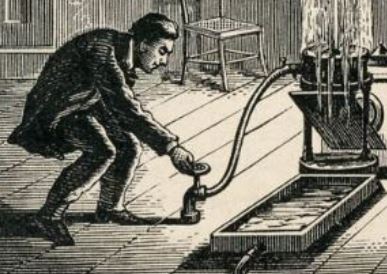In 1849, the apparatus used in the 3rd act of the stage play ‘The Prophet’ (Le prophète, Paris 16 April), to imitate the rising sun, consisted of an arc lamp fitted with a large ‘parabolic reflector’ (below).
Engraving below of Act IV, scene 2 in ‘L'Illustration’ 24 April 1849. https://t.co/qmtAiCgMb5
In the first act of the opera ‘Moïse et Pharaon’ in 1860, electricity was first applied to produce a rainbow.
A lantern equipped w/ an electric arc is placed on a scaffolding of suitable height, 5 meters from the curtain and perpendicular to the canvas which represents the sky. https://t.co/nX9A4D56wp
In 1611, astronomer Johannes Kepler (above) described the basic notion of the ‘Camera Lucida’.
In 1806, William Hyde Wollaston (below) invented an instrument with a four-sided prism, almost 200 years later. https://t.co/OLiy3RAljp
It’s been documented many times that Florence La Badie was the only major Motion Picture star to die at the peak of their stardom.
This may be true, however names like Carole Lombard, Wallace Reid and Jean Harlow immediately come to mind. https://t.co/OLbJYEpYfZ
An engraving (r) from the book ‘Au Random du Chemin’ by M & Mme Satanislas Meunier - J. Rothschild publisher in Paris 13 rue des Saint-Pères. C. 1886. See the ‘Lampadorama’ bottom left corner. https://t.co/eml8QSzjpp
18TH CENTURY LANTERN ENGRAVING
This beautiful 18th century print, entitled ‘La Lanterne Magique d’Amour’ (The Magic Lantern of Love), was engraved by Pierre Michel Alix (1762-1817), after a painting by Jean Frédéric Schall (1752-1825).
Marey's mobile camera allowed the birds to be followed easily. Simply by aiming his gun at the flying birds, Marey was able to place twelve exposures along the outer edge of the plate.
Pictured is Eadweard Muybridge’s Cockatoo 1884. https://t.co/X5a7jlffD3
Here’s a four-page reference to, and illustrations for the ‘Pamphengos’ figs.11 & 12 taken from ‘The Art of Projection and Complete Magic Lantern Manual’ by Expert, Published by E. A. Beckett, London, 1893, pp13-16. -30- https://t.co/h86mRTfO4A
The ‘Fountain of Colladon’ was a luminous fountain consisting of projecting light inside a stream of water.
In the engraving a man regulates the flow of water that feeds a fountain placed in the centre of a container intended to collect the water (l).
J-D. Colladon (r). https://t.co/DBjgWrzqcN
1877
JEAN-DANIEL COLLADON (1802-1893)
In 1877, we find in an American book called ‘The Art of Projection’ by Prof. Amos Emerson Dolbear, a very interesting description of luminous fountains, with this superb engraving, below.
It was known as the luminous ‘Fountain of Colladon’.






















